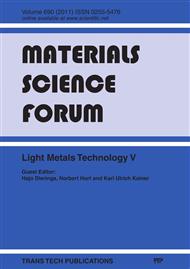p.459
p.465
p.469
p.473
p.477
p.481
p.487
p.491
p.495
Cyclic Deformation of Newly Developed Magnesium Cast Alloys in Corrosive Environment
Abstract:
The moderate corrosion rate exhibits by Mg-RE alloys make it candidate material for biodegradable implant. Owing to the operating environment, implants are subjected to stochastic cyclic load and chemical condition. The alloys response to the subjected condition determines its degree of applicability. This work studies the cyclic deformation of newly developed Mg10GdxNd alloys both in air and under corrosive environment. The corrosion fatigue test was carried out in Ringer-Acetate solution and was evaluated using mechanical hysteresis and pH-value measurements. The microstructural changes in correlation to the deformation parameters and fracture surfaces were characterized using SEM. Results show that alloying Mg10Gd with Neodymium improved its fatigue live both in air and corrosive medium. Chilled casted Mg10Gd and Mg10GdxNd were found to undergo brittle fracture in both media. Loading in Ringer-Acetate was found to reduce the fatigue life of the investigated alloys due to the interaction of corrosion and fatigue processes on the microstructure of the alloys. EDX analysis suggests that the improved fatigue life observed on the Mg10GdxNd is connected to the new ternary Mg-Gd-Nd phase observed in the microstructure.
Info:
Periodical:
Pages:
495-498
Citation:
Online since:
June 2011
Authors:
Keywords:
Price:
Сopyright:
© 2011 Trans Tech Publications Ltd. All Rights Reserved
Share:
Citation:


